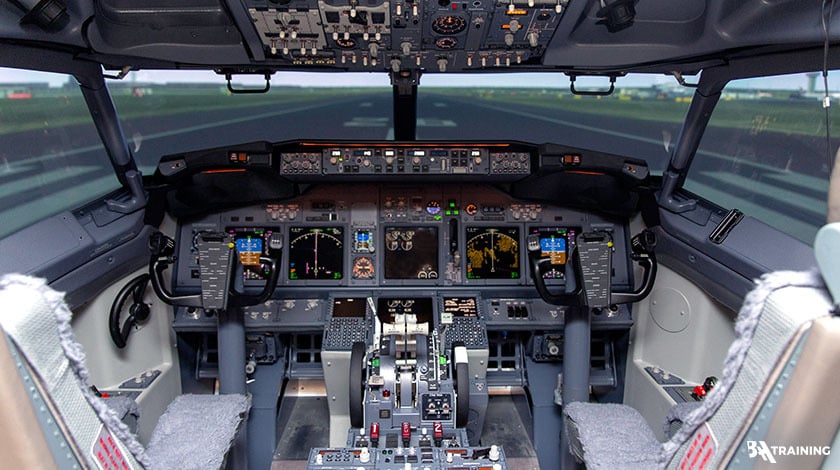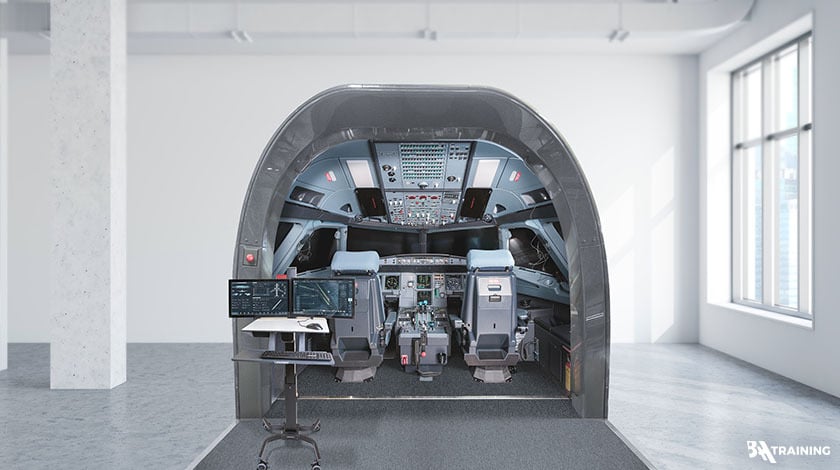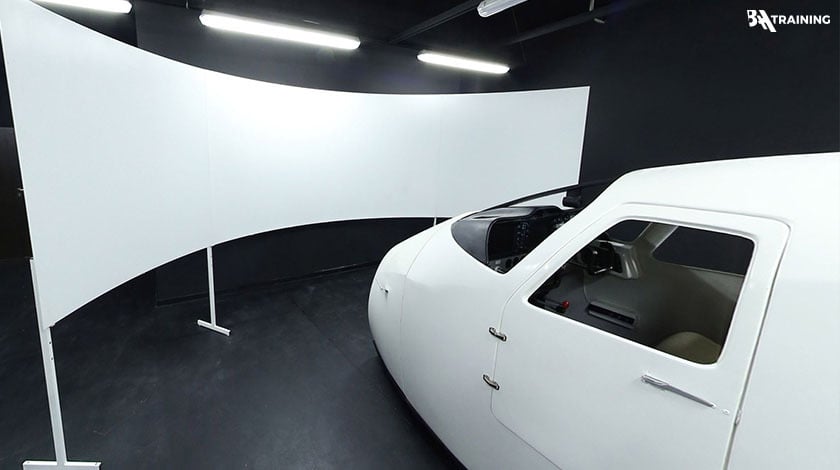Photo: BAA Training
Reading Time: 4 minutesAlmost every future pilot uses at least one of the FSTD devices at some point in their training. The abbreviation stands for “flight simulation training devices.” It is an umbrella term for various equipment used to simulate flights during pilot training. The FSTD concept encompasses full flight simulators (FFSs), flight training devices (FTDs), flight navigation procedures trainers (FNPTs), and basic instrument training devices (BITDs).
Full Flight Simulator (FFS)
An FFS is the most widely used training device in pilot training and the most advanced and in terms of its design and functionality.
FFS training constitutes practicing in a highly innovative virtual environment for completing Type Rating, recurrent training and licence proficiency checks. Completely accurate replication of a type-specific cockpit (e.g., Airbus A320 or Boeing 737) with motion and sound systems, an instructor station, and an aircraft data package allow a trainee pilot to get a “feel of flying.” The visual systems provide minimum 180×40-degree view in satellite quality.
According to EASA and FAA classification, FFS levels are lettered A, B, C, and D, with level D being the most sophisticated and having the highest fidelity level (the extent to which it resembles the actual aircraft). The D-level simulators are also eligible for Zero Flight Time Training (ZFT), which refers to training on an aircraft type rating course (conversion to a new type of aircraft) conducted entirely in a simulator.
The FFSs are expensive – they can cost up to EUR 7-10 million. In 2019, the FFS segment accounted for more than 90% of the market share.

Flight Training Device (FTD)
An FTD is a flight training device with a grounded base (can be referred to as FBS – fixed-base simulator).
The key FTD’s distinctive characteristics are the absence of both a motion system.FTDs, similarly to FFSs, have different sophistication levels, which are marked by numbers instead of letters in this case. EASA recognizes FTD Level 1, FTD Level 2, and FTD Level 3 (helicopters only) training devices. As the number grows, so does the degree of complexity.
FTDs are often used to train standard operating procedures, checklist flow, aircraft systems, carry out MCC/JOC courses, and so on. Although an FTD cannot fully substitute an FFS for Type Rating, the recent EASA regulation changes authorize completion of part of a Type Rating program on FTDs, thus providing trainees with an opportunity to cut their expenditures. Training academies can also use an FTD in Phase 1 and Phase 2 of the ATPL or CPL program.
However, it is mandatory to switch to an FFS for certain types of courses. For example, FTDs are not suited for “upset prevention and recovery training” (UPRT) designed to build flight crew’s competencies of preventing and recovering from situations when an aircraft exceeds the standard parameters.
The purchase and operating costs of FTDs are much cheaper than those of FFSs. Typically, the acquisition price would be 0,7-1,5 million.

Flight and navigation procedures trainer (FNPT)
Unlike flight simulators, FNPTs usually represent an airplane class but not a type (although sometimes they are manufactured with a specific type in mind) and have a fixed-base generic system.
FNPT I is the most basic equipment only representing the flight deck. In contrast, an FNPT II goes as far as to create the flight deck environment of a multi-engine airplane type or class with systems functioning the same as they do in the airplane. A visual system providing an out-of-the-flight deck view is incorporated. One more version – FNPT MCC – is used for performing Multi-Crew Coordination (MCC) training.
An FNPT can be used for IFR, ME, IR/MEP Rating, and PBN courses within the ATPL/CPL programs. Sometimes it is insignificant whether to use an FNPT I or an FNPT II. For example, having pretty graphics (supported by FNPT II) during the IR training is irrelevant; therefore, a more limited version is sufficient to achieve the same result.
This device can be further applied in training for pilot licence and periodic licence renewal examinations, instrument flight refresher and skill maintenance sessions, night flight training, etc.
FNPTs are usually more affordable than FTDs or FFSs.

FSTDs at BAA Training
BAA Training’s current in-house training equipment includes two FNPT II devices simulating Cessna 172N , Tecnam P2006T and Piper PA44 and the following list of FFSs:
- Lithuania, Vilnius – 2 Airbus A320, Boeing 737NG and Boeing 737CL+ 2APT
- Spain, Barcelona – Airbus A320ceo, Boeing 737 MAX, Airbus A320ceo/neo (soon ready for training)
- Vietnam, Hoh Chi Minh – 1 Airbus A320ceo, 1 Airbus A320neo
- China, Zhengzhou – Boeing 737NG
BAA Training has also ordered a number of FTD devices that, when used in combination with FFSs, will provide our customers with an opportunity to reduce costs or add more training hours without extending the budget, all in line with EASA regulation.
Having the above-listed simulators ensures pilots undergoing Type Rating and other courses at BAA Training in different locations receive quality training on the respective equipment.
In conclusion, various FSTDs simulate aircraft avionics, controls forces, instruments, sounds, etc., for pilots across multiple training programs and phases. Although FFSs surpass both FTDs and FNPTs by their capabilities, the latter can also be successfully incorporated into the training plan where appropriate and authorized by EASA, enabling both training providers and clients to be cost-efficient.

